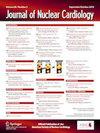心脏PYP扫描中模拟ATTR的AHL淀粉样变性:诊断难题。
IF 3
4区 医学
Q2 CARDIAC & CARDIOVASCULAR SYSTEMS
引用次数: 0
摘要
背景:淀粉样变性是一种以淀粉样原纤维沉积为特征的多系统疾病,可导致器官功能障碍。当怀疑心脏淀粉样变性时,筛查轻链淀粉样变性(AL)和转甲状腺素淀粉样变性(ATTR)是必要的,这是两种最常见的亚型。病例介绍:我们报告一位以晚期心力衰竭和轻度肾功能不全为首发症状的患者。初步检测显示轻链比轻微异常,Tc-99 m焦磷酸盐(PYP)扫描强烈阳性。心脏、骨髓和肾脏活检证实淀粉样变性。进一步的免疫荧光和质谱分析鉴定出免疫球蛋白G和λ轻链沉积物。该患者被诊断为多发性骨髓瘤和重、轻链淀粉样变性(AHL),并开始使用环磷酰胺、硼替佐米和地塞米松治疗,而不是他法米迪斯(一种用于ATTR的口服转甲状腺素动力学稳定剂)。结论:AHL淀粉样变是一种罕见的亚型。本病例表明,PYP扫描阳性,即使有强烈摄取,也不完全是atr的特异性。组织确认对于明确诊断至关重要,特别是当怀疑轻链疾病或其他罕见形式时,因为AL/AHL和ATTR具有不同的治疗和预后,并且可能共存。本文章由计算机程序翻译,如有差异,请以英文原文为准。
AHL amyloidosis mimicking transthyretin amyloidosis on cardiac Tc-99 m pyrophosphate scan: A diagnostic challenge
Background
Amyloidosis is a multisystem disease characterized by the deposition of amyloid fibrils, leading to organ dysfunction. When cardiac amyloidosis is suspected, it is essential to screen for light chain amyloidosis (AL) and transthyretin amyloidosis (ATTR), the two most common subtypes.
Case presentation
We report a patient with advanced heart failure and mild kidney dysfunction as initial symptoms. Preliminary testing revealed a slightly abnormal light chain ratio and a strong positive Tc-99 m pyrophosphate (PYP) scan. Biopsies of the heart, bone marrow, and kidney confirmed amyloidosis. Further immunofluorescence and mass spectrometry analysis identified immunoglobulin G and lambda light chain deposits. The patient was diagnosed with multiple myeloma and heavy and light chain amyloidosis (AHL) and initiated treatment with cyclophosphamide, bortezomib, and dexamethasone, rather than tafamidis, an oral transthyretin kinetic stabilizer used for ATTR.
Conclusions
AHL amyloidosis is a rare subtype. This case demonstrates that a positive PYP scan, even with intense uptake, is not entirely specific for ATTR. Tissue confirmation is essential for a definitive diagnosis, particularly when light chain disease or other rare forms are suspected, because AL/AHL and ATTR have distinct treatments and prognoses and may coexist.
求助全文
通过发布文献求助,成功后即可免费获取论文全文。
去求助
来源期刊
CiteScore
5.30
自引率
20.80%
发文量
249
审稿时长
4-8 weeks
期刊介绍:
Journal of Nuclear Cardiology is the only journal in the world devoted to this dynamic and growing subspecialty. Physicians and technologists value the Journal not only for its peer-reviewed articles, but also for its timely discussions about the current and future role of nuclear cardiology. Original articles address all aspects of nuclear cardiology, including interpretation, diagnosis, imaging equipment, and use of radiopharmaceuticals. As the official publication of the American Society of Nuclear Cardiology, the Journal also brings readers the latest information emerging from the Society''s task forces and publishes guidelines and position papers as they are adopted.

 求助内容:
求助内容: 应助结果提醒方式:
应助结果提醒方式:


